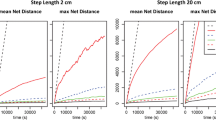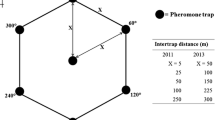Abstract
Methods are presented for mathematically determining dispersal of a vapor in still air, in turbulent air of zero average velocity, and in turbulent or laminar air currents of constant, nonzero average velocity. The methods are combined with several assumptions about insect behavior to derive an insect attraction model that predicts: (1) In a warehouse a searching insect is likely to be attracted to a calling insect if it comes within an attraction sphere, 0.4–2.5 m in radius. (2) The attraction spaces of typical sex pheromone-baited traps that emit pheromone at rates greater than 0.01 ng/sec extend beyond the boundaries of a 10 × 10 × 10-m warehouse. (3) The searching behavior of an attracted insect is likely to be altered from an extensive to an intensive pattern if it comes within an altered-behavior sphere, 6–60 cm from a calling insect or within 10 m of a trap emitting 0.76 ng/sec. (4) Pheromone does not sink unless it is emitted along with a large amount of a high-vapor pressure solvent. The model is used in support of several hypotheses, including: (1) The effect of an adsorptive surface on the vapor concentration after an extended period of emission is negligible except at positions near the surface. (2) Sex pheromone-baited traps with sources of small dimensions have greater trapping efficiency than otherwise identical traps with sources of large dimensions.
Similar content being viewed by others
References
Allen, L.H., Jr. 1975. Line-source carbon dioxide release III. Predictions by a two-dimensional numerical diffusion model.Boundary-Layer Meteorol. 8:39–79.
Aylor, D.E. 1976. Estimating peak concentration of pheromones in the forest, pp. 177–188,in J.E. Anderson and H.K. Kaya (eds.). Perspectives in Forest Entomology. Academic Press, New York.
Aylor, D.E., Parlange, J.-Y., andGranett, J. 1976. Turbulent dispersion of disparlure in the forest and male gypsy moth response.Environ. Entomol. 5:1026–1032.
Baker, T.C., andCardé, R.T. 1979. Courtship behavior of the Oriental fruit moth (Grapholitha molesta): Experimental analysis and consideration of the role of sexual selection in the evaluation of courtship pheromones in the Lepidoptera.Ann. Entomol. Soc. Am. 72:173–188.
Barak, A., andBurkholder, W.E. 1976. Trapping studies with dermestid sex pheromones.Environ. Entomol. 5:111–114.
Bartell, R.J., andLawrence, L.A. 1977. Reduction in responsiveness of male apple moths,Epiphyas postvittana, to sex pheromone following pulsed pheromonal exposure.Physiol. Entomol. 2:1–6.
Bjostad, L.B. 1978. Quantitative chemical determination of the temporal pattern of sex pheromone release by femaleTrichoplusia ni (Noctuidae). PhD dissertation, University of California, Riverside.
Bossert, W.H. 1968. Temporal patterning in olfactory communication.J. Theor. Biol. 18:157–170.
Bossert, W.H., andWilson, E.O. 1963. The analysis of olfactory communication among animals.J. Theor. Biol. 5:443–469.
Cain, W.S., andEngen, T. 1969. Olfactory adaptation and the scaling of odor intensity, pp. 127–141,in C. Pfaffmann (ed.). Olfaction and Taste III. Rockefeller University Press, New York.
Carslaw, H.S., andJaeger, J.C. 1967. Conduction of Heat in Solids. Oxford University Press, London.
Chamberlain, A.C. 1953. Experiments on the deposition of iodine 131 vapor onto surfaces.Phil. Mag. 44:1145–1153.
Chamberlain, A.C. 1966. Transport of gases to and from grass and grass-like surfaces.Proc. R. Soc. (London) A290:236–265.
Draxler, R.P., andElliot, W.P. 1977. Long-range travel of airborne material subjected to dry deposition.Atmos. Environ. 11:35–40.
Farkas, S.R., andShorey, H.H. 1974. Mechanisms of orientation to a distant pheromone source, pp. 81–95,in M.C. Birch (ed.). Frontiers of Biology 32. American Elsevier, New York.
Gifford, F.A. 1960. Atmospheric dispersion.Nuclear Safety 1:56–69.
Hammack, L., Ma, M., andBurkholder, W.E. 1976. Sex pheromone-releasing behavior in females of the dermestid beetle,Trogoderma glabrum.J. Insect Physiol. 22:555–561.
Hartstack, A.W., Jr., Witz, J.A., Hollingsworth, J.P., andBull, D.L. 1976. SPERM-A sex pheromone emission and response model.Trans. ASAE 19:1170–1174, 1180.
Hienton, T.E. 1974. Summary of investigations of electric insect traps. USDA Tech. Bull. No. 1498.
Hinze, J.O. 1975. Turbulence. McGraw-Hill, New York.
Hirooka, Y., andSuwanai, M. 1976. Role of insect sex pheromone in mating behavior. I. Theoretical consideration on release and diffusion of sex pheromone in the air.Appl. Entomol. Zool. 11:126–132.
Judeikis, H.S., andStewart, T.B. 1976. Laboratory measurements of SO2 deposition velocities on selected building materials and soils.Atmos. Environ. 10:769–776.
Kennedy, J.S. 1974. Pheromone-regulated anemotaxis in flying moths.Science 184:999–1001.
Killinen, R.G., andOst, R.W. 1971. Pheromone-maze trap for cabbage looper moths.J. Econ. Entomol. 64:310–311.
Knipling, E.F., andMcguire, J.U. 1966. Population models to test theoretical effects of sex attractants used for insect control. USDAAgric. Info. Bull. 308.
Lamb, R.G., scChen, W.H., andSeinfeld, J.H. 1975. Numerico-empirical analyses of atmospheric diffusion theories.J. Atmos. Sci. 32:1794–1807.
Lewis, T., andMacaulay, E.D.M. 1976. Design and elevation of sex-attractant traps for pea moth,Cydia nigricana (Steph.), and the effect of plume shape on catches.Ecol. Entomol. 1:175–187.
Lugg, G.A. 1968. Diffusion coefficients of some organic and other vapors in air.Anal. Chem. 40:1072–1077.
Lundberg, W.O. 1961. Autoxidation and Antioxidants, I. Interscience, New York.
Macaulay, E.D.M., andLewis, T. 1977. Attractant traps for monitoring pea Moth, Cydia nigricana (Fabr.).Ecol. Entomol. 2:279–284.
Mankin, R.W., Vick, K.W., Mayer, M.S., andCoffelt, J.A. 1980. Anemotactic response threshold of the Indian meal moth,Plodia interpunctella (Hubner) (Lepidoptera: Pyralidae) to its sex pheromone.J. Chem. Ecol 6:919–928.
Marks, R.J. 1978. The influence of pheromone trap design and placement on catch of the red bollworm of cottonDiparopsis castanea Hampson (Lepidoptera: Noctuidae).Bull. Entomol. Res. 68:31–45.
Mayer, M.S. 1973. Attraction studies of maleTrichoplusia ni (Lepidoptera: Noctuidae) with new combination of olfactometer and pheromone dispenser.Ann. Entomol. Soc. Am. 66:1191–1196.
Monchieck, L., andMason, E.A. 1961. Transport properties of polar gases.J. Chem. Phys. 35:1676–1697.
Murliss, J., andBettany, B.W. 1977. Night flight toward sex pheromone source by maleSpodoptera littoralis (Boisd.) (Lepidoptera: Noctuidae).Nature 268:433–435.
Nakamura, K. 1976. The active space of the pheromone ofSpodoptera litura and the attraction of adult males to the pheromone source, pp. 145–155,in T. Yushima (ed.). Insect Pheromones and Their Applications. National Institute of Agricultural Science, Tokyo.
Nakamura, K., andKawasaki, K. 1977. The active space of theSpodoptera litura (F.) sex pheromone and the pheromone component determining this space.Appl. Entomol. Zool. 12:162–177.
Nakamura, K., andOyama, M. 1978. An equation for the competition between pheromone traps and adult females for adult males.Appl. Entomol. Zool. 13:176–184.
Pasquill, F. 1961. The estimation of the dispersion of windborne material.Meteorol. Mag. 90:33–53.
Perez, R.P., andHensley, S.D. 1973. Recapture of sugarcane borer [Diatraeasaccharalis (F.)] males released at different distances from pheromone-baited traps.J. Agric. (Puerto Rico) 57:330–342.
Protter, M.H., andMorrey, C.B., Jr. 1966. Modern Mathematical Analysis. Addison-Wesley, Reading, Massachusetts.
Read, J.S., andHaines, C.P. 1976. The functions of the female sex pheromones ofEphestia cautella (Walker) (Lepidoptera: Phycitidae).J. Stored Prod. Res. 12:49–53.
Reichmuth, C.H., Wohlgemuth, R., Levinson, A.R., andLevinson, H.Z. 1976. Untersuchungen uber den Einsatz von pheromonbekoderten klebefallen zur Bekämpfung von motten im Vorratsschutz.Z. Angew. Entomol. 82:95–102.
Reichmuth, C.H., Schmidt, H.U., Levinson, A.R. andLevinson, H.Z. 1978. Die Fängigkeit pheromonbeköderter Klebefallen für Speichermotten (Ephestia elutella (Hbn.)) in unterschiedlich dicht befallenen Getreidelagern.Z. Angew. Entomol. 86:205–212.
Roelofs, W.L. 1975. Manipulating sex pheromones for insect suppression, pp. 41–59,in M. Jacobson (ed.). Insecticides of the Future, Marcel Dekker, New York.
Roelofs, W.L. 1978. Threshold hypothesis for pheromone perception.J. Chem. Ecol. 4:685–699.
Sears, F.W. 1958. Mechanics, Wave Motion, and Heat. Addison-Wesley, Reading, Massachusetts.
Shapas, T.J., andBurkholder, W.E. 1978. Patterns of sex pheromone release from adult females and effects of air velocity and pheromone release rates on theoretical communication distances inTrogoderma glabrum.J. Chem. Ecol. 4:395–408.
Shorey, H.H., andGaston, L.K. 1965. Sex pheromones of noctuid moths. VIII. Orientation to light by pheromone-stimulated males ofTrichoplusia ni (Lepidoptera: Noctuidae).Ann. Entomol. Soc. Am. 58:833–836.
Shorey, H.H., andMcKelvey, J.J., Jr. 1977. Chemical Control of Insect Behavior: Theory and Application. Wiley-Interscience, New York.
Skelland, A.H.P. 1974. Diffusional Mass Transfer. John Wiley & Sons, New York.
Sower, L.L., andFish, J.C. 1975. Rate of release of the sex pheromone of the female Indian meal moth.Environ. Entomol 4:168–169.
Sower, L.L., Gaston, L.K., andShorey, H.H. 1971. Sex pheromones of noctuid moths. 26. Female release rate, male response threshold, and communication distance ofT. ni.Ann. Entomol. Soc. Am. 64:1448–1456.
Sower, L.L., Long, J.S., Vick, K.W., andCoffelt, J.A. 1973. Sex pheromone of the Angoumois grain moth: Effects of habituation on the response of the male.Ann. Entomol. Soc. Am. 66:991–995.
Sower, L.L., Turner, W.K., andFish, J.C. 1975. Population-density-dependent mating frequency amongPlodia interpunctella (Lepidoptera: Phycitidae) in the presence of synthetic sex pheromone with behavioral observations.J. Chem. Ecol. 1:335–342.
Sutton, O.G. 1953. Micrometeorology. McGraw-Hill, New York.
Thompson, R.F., andSpencer, W.A. 1966. Habituation: A model phenomenon for the study of neuronal substrates of behavior.Psychol. Rev. 73:16–43.
Traynier, R.M.M. 1968. Sex attraction in the Mediterranean flour moth,Anagasta kühniella: Location of the female by the male.Can. Entomol. 100:5–10.
Veigele, W.J., andHead, J.H. 1978. Derivation of the gaussian plume model.J. Air Poll. Control Assoc. 28:1139–1141.
Vick, K.W., Kvenberg, J., Coffelt, J.A., andSteward, C. 1979. Investigation of sex pheromone traps for simultaneous detection of Indian meal moths and Angoumois grain moths.J. Econ. Entomol. 72:245–249.
Visser, J.H. 1976. The design of a low-speed wind tunnel as an instrument for the study of olfactory orientation in the Colorado beetle (Leptinotarsa decemlineata).Entomol. Exp. Appl. 20:275–288.
Wall, C., andPerry, J.N. 1978. Interactions between pheromone traps for the pea moth,Cydia nigicana (F.).Entomol. Exp. Appl. 24:155–162.
Wilson, E.O., Bossert, W.H., andRegnier, F.E. 1969. A general method for estimating threshold concentrations of odorant molecules.J. Insect Physiol. 15:597–610.
Wright, R.H. 1958. The olfactory guidance of flying insects.Can. Entomol. 90:81–89.
Author information
Authors and Affiliations
Rights and permissions
About this article
Cite this article
Mankin, R.W., Vick, K.W., Mayer, M.S. et al. Models for dispersal of vapors in open and confined spaces: Applications to sex pheromone trapping in a warehouse. J Chem Ecol 6, 929–950 (1980). https://doi.org/10.1007/BF00990477
Received:
Revised:
Issue Date:
DOI: https://doi.org/10.1007/BF00990477




